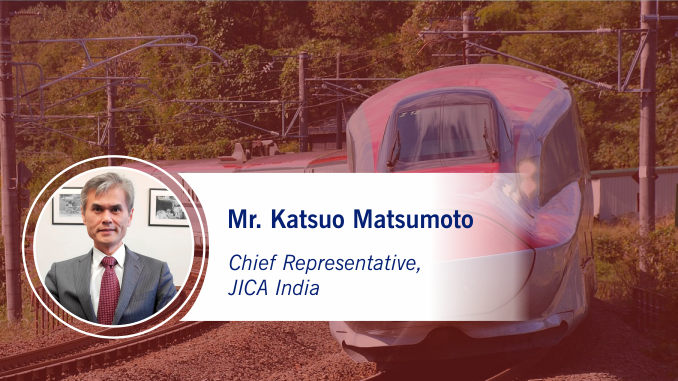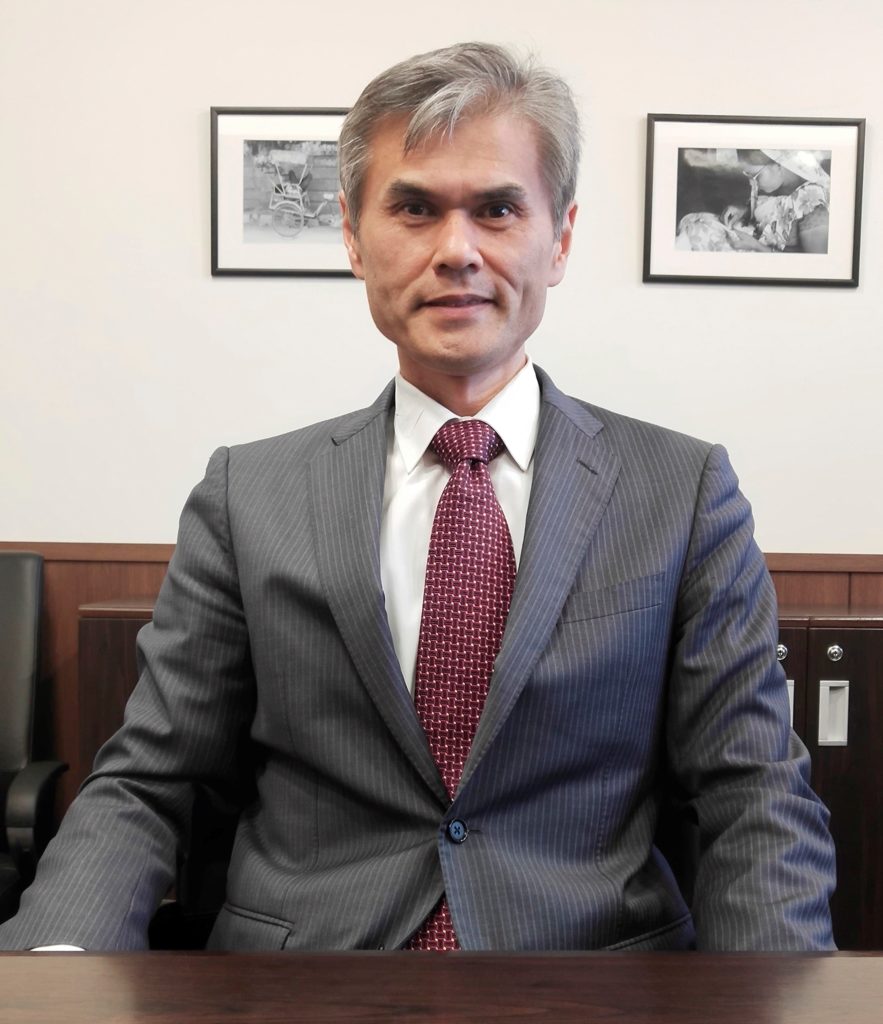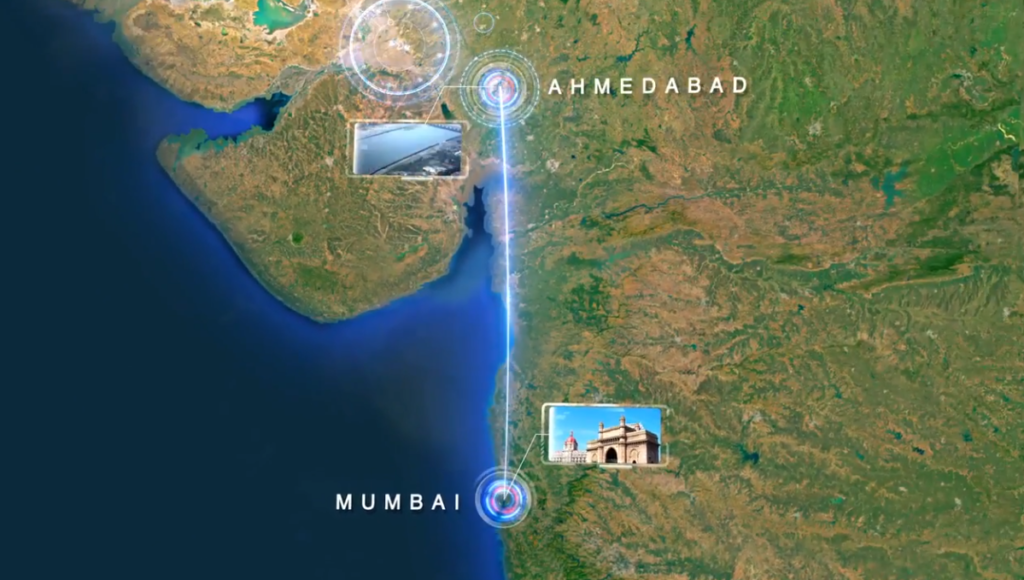
 Mr. Katsuo Matsumoto,
Mr. Katsuo Matsumoto,
Chief Representative, JICA India
The Japan International Cooperation Agency (JICA) announced appointment of Mr. Katsuo Matsumoto as the new Chief Representative of JICA India Office on June 1, 2018. Previous to this, Mr. Matsumoto was closely engaged in the work related to the South Asian region while being the Deputy Director General of South Asian Department at the JICA Headquarters, Tokyo. He has rich experience of working for some of the largest Official Development Assistance (ODA) loan projects in the South Asian region. Through his frequent visits to India, Mr. Matsumoto acquired immense familiarity and interest in working with India as well as understanding of developmental needs of the country.
Rail Analysis: Firstly we would like to know about the factors that make JICA the world’s largest bilateral aid agency and India’s largest development partner?
Mr. Katsuo Matsumoto: JICA is the world’s largest bilateral aid agency and India is its largest development partner. JICA is committed to support India’s holistic growth across sectors. For this goal, we have supported more than 60 projects in India across vital areas such as transport, water and sanitation, energy, forestry and agriculture in FY2018 where the total committed amount was 398.4 billion Japanese Yen (approximately INR. 24,160 Crore.) Japan’s ODA to India started in 1958, when a concessionary ODA loan of 18 billion Japanese Yen was extended to supplement the implementation of the 2nd Five-Year Plan, at the request of the then Prime Minister, Jawaharlal Nehru. India was then the first recipient in the world of Japanese ODA loan. Since then, over 5,200 billion Japanese Yen (approximately INR 315,150 Crore) in ODA loans have been committed for development across various sectors. Technical Cooperation with India started in 1966. Since then, nearly 8,300 Indian personnel have participated in training courses in Japan and over 8,600 Japanese experts have come to India to offer their expertise. Grant aid has also covered various areas in India including construction of hospitals and health facilities, and providing equipment for educational institutions. Through these efforts we aim to see India achieving its own development goals.

JICA Signs Agreement with India to Provide Rs 5591 Crore Loan for Mumbai-Ahmedabad Bullet
Train Project
Rail Analysis: What are your other interesting projects going in India for the railway and metro sector?
Mr. Katsuo Matsumoto: JICA has been actively contributing to the improvement of public transportation systems in India, along with the support of the Indian partners, to ensure balanced regional and economic growth. Our activities seek to achieve accelerated development of Indo-Japan ties. JICA is currently working on 8 projects in the railway sector namely Dedicated Freight Corridor Project, Capacity Development on Railway Safety, Mumbai – Ahmedabad High-Speed Rail Project, and metro projects in 5 major cities of India – Ahmedabad Metro, Chennai Metro, Delhi Metro, Mumbai Metro and Kolkata Metro. JICA has invested more than 2,040 billion Japanese Yen, (approximately INR 136,000 Crore) in Railway Sector in India
“JICA supports various aspects of transport, such as formulation of masterplans, assistance for introduction of related technologies, construction of roads, bridges, railways and metros, and more.”

The Joint Coordination Committee (JCC) meeting for “Capacity Development on Railway Safety” held at New Delhi was attended by dignitaries from both Japan and India
Rail Analysis: In reference to the continued commitment of JICA for Global Projects, what are the points of consideration for JICA before investing in a project?
Mr. Katsuo Matsumoto: JICA works in tandem with the partner country’s goals across sectors to propel their growth with the help of Japan’s expertize. The thought behind projects funded by JICA is to bring sustainable growth in partner countries and bring benefits to people by supporting projects which prove to be cost-effective in the long run and help bridging the socio-economic gap.

Participants undergoing a Knowledge Co-Creation Program.
Rail Analysis: Is the Social Rate of Return the main aspect or are there other key considerations also?
Mr. Katsuo Matsumoto: JICA’s actively strives to achieve Social Rate of Return through its projects that are aimed for sustainable growth, poverty alleviation, environment conservation, and so on. JICA’s focus is to continue providing support towards sustainable development and inclusive growth, with a goal of poverty reduction. We focus on aligning our projects with India’s national priorities and long-term vision. Cross cutting issues such as adequate environmental and social considerations, gender mainstreaming and people to people exchange are also encouraged.

Rail Analysis: Recently it was announced that JICA and Indian Railways held a second consultative meeting on technical cooperation. Please share with our readers more on the same?
Mr. Katsuo Matsumoto: JICA is currently implementing the Technical Corporation (TC) Project ‘Capacity Development on Railway Safety’, which aims to enhance the capacity of the Indian Railways (IR) and the Dedicated Freight Corridor Corporation of India Limited (DFCCIL). The consultative meeting was held for discussion by JICA Experts, who are jointly working with officials of Indian Railways, Commissioners of Rail Safety and DFCCIL, for mutual learning and creating the implementable Action Plans for safer railway operations in India. Under this TC, total 60 Indian officials have been invited to Japan for the training in the field of Safety Management, Track maintenance, Rail welding, Rolling stock maintenance,Safety Management, and India aims to continue imparting good practices through its projects in India.
Rail Analysis: How do you view the Indian economy in the next 5 years? What is your opinion on the modernization drive of the Indian Railways including High-Speed Rail Project?
Mr. Katsuo Matsumoto: India is one of the fast growing economies of the world, and it has successfully achieved milestones of development. With the growing population and economic stability, it continues to be a powerhouse for plethora of opportunities. If the financial expert reports and the current government’s claims are to be considered than India will rise to the level of 3rd largest economy in the world. The friendship and cooperation between India and Japan is also expected to deepen further.
“JICA would continue to contribute to the creation of world-class infrastructure in India, both technically and financially. The modernizing Indian Railways including the High-Speed Rail Project will help in holistic regional development, faster and efficient mobility solutions, thereby improving the standard of living for the Indian population.”

JICA Providing funds for Chennai Metro
Rail Analysis: Any other information you would like to share with our readers?
Mr. Katsuo Matsumoto: The assistance of JICA has never been restricted to providing of loans but depending on the nature of the requirement, we have extended our contribution in form of technical assistance, JICA volunteers program, JICA partnership program, trainings programs in Japan and other country, and Grant Aids.Sharing of the technology, knowledge and experience is JICA’s core competency; like in case of Delhi Metro we induced Japanese culture of punctuality and timeliness in the operation of metro. The Japanese concept of Satoyama has been introduced in the Forestry projects to ensure integration of conservation and the sustainable use of biodiversity in production landscapes. JICA has also been involved in technical cooperation project in making Indian Railway safer and more reliable. Japan’s expertise lies in disaster prevention and risk mitigation, which is why a technical cooperation project in Uttarakhand supported by JICA appropriately plans and implements erosion control work for slope disaster management in forest areas of the State, to mitigate the effects of natural disasters timely and most effectively, as a part of future preparedness strategy.

